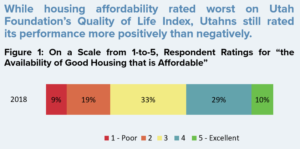
Interestingly, however, when asked whether their own housing was affordable, only a small minority indicated that it was not.
Housing costs tend to be a household’s largest single expense. And in Utah, housing prices have increased sharply during the past five years; the median sales price of a home rose from $207,000 in 2013 to $298,950 in 2018. While homebuyers have seen a 44% increase in prices, renters are also seeing higher costs. Median rents in Utah increased from $851 in 2012 to $986 in 2017.
This policy brief looks closely at three housing affordability questions in the Quality of Life Index survey. The brief is a supplement to the full report, Utah Foundation Quality of Life Index: Measuring Utahns’ Perceptions of their Communities, Personal Lives, released in September 2018.
Key Findings of this Report
- Housing affordability has the lowest rating in the 2018 Community Quality of Life Index.
- Of the 20 aspects on the index, housing affordability had the largest decline.
- Housing affordability in general is of greater concern for older Utahns than younger ones.
- When asked whether they felt their personal housing costs were affordable, only 12% of respondents said no. However, in Salt Lake County, that number was 20%.
- Respondents with lower incomes, those who are renters and those who live in Salt Lake County were more likely than other Utahns to feel that their own housing is unaffordable.
- When adjusting for inflation, Utah homeowners’ monthly costs have decreased by 10% since 2007, while renters’ costs have increased by 14%.
- More people gave a poor rating to “how affordable housing is for individuals in all income levels” than gave an excellent rating. However, nearly half of the respondents gave neutral responses.
- Those who are not religiously affiliated, renters and residents of Salt Lake County were more likely to be concerned about housing affordability across income levels.
- When compared to other large metros in the west, Utah’s housing costs are relatively favorable.

